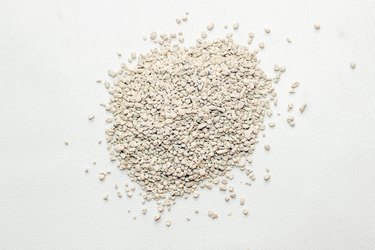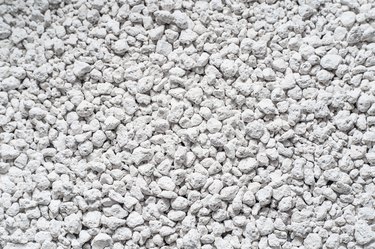
Cat owners may be hip to the incredible versatility of cat litter, but its effectiveness as a dehumidifier is a little-known hack every homeowner must know. Cat litter (also referred to as kitty litter) is designed to absorb moisture from indoor cat waste, making it easy for their humans to dispose of all their "business." For the rest of the population, cat litter is a common, affordable product that absorbs moisture (and odors) like crazy. This makes cat litter a formidable product for dehumidifying small spaces and more. The beauty of cat litter is that it can absorb moisture through direct contact, and it even absorbs it passively from the atmosphere, so once you put it in a room — even if you just open the bag — it'll do the work by itself.
What Is Cat Litter?
Video of the Day
Intended as a desiccant for cat waste, cat litter is so effective at passively absorbing atmospheric moisture that cat owners are advised to use a dehumidifier in their cat's litter room in order to extend the life of litter in the wintertime.
Video of the Day
As for what cat litter is composed of, it can be many things. Sodium bentonite clay has historically been the big product, as it can be a clumping cat litter that makes waste removal a cinch for pet owners. For varying reasons — the dust levels, the slow biodegrading, and even because dogs like to munch on used clumping litter (eww) — sodium bentonite clay isn't the runaway leader in the cat litter race anymore. Coming up from behind are numerous new, popular products that all have varying qualities that cat caregivers now seek.
Silica gel crystals are popular with some humans for producing little or no dust and super effectively controlling odor. Plus, they're less likely to trigger allergies. For others, natural products are becoming popular due to their environmental friendliness and sustainable nature. These can include clumping products that are made from wood and green tea, wheat, recycled paper, corn, and other materials that can be composted for quick breakdown. Today's consumers choose cat litters based on many characteristics, such as recyclability and dust level, as well as absorption. But if you're looking to reduce air moisture, look for the most absorptive material available.
How to Use Cat Litter as a Dehumidifier

The thing about cat litter for dehumidifying a space or object is that it's like real estate — it all comes down to location. If you have an 800-square-foot garage from which you're trying to remove dampness so you can tackle a painting project in the dead of winter, cat litter is probably not the solution you're looking for. For a larger area, use a machine. But for smaller spaces, litter is a great choice. For example, cat litter is an ideal way to prevent mildew growth and remove excess moisture from your musty camper while it's parked for the winter.
1. Controlling Humidity in Storage Units and Small Spaces
For small spaces, like storage sheds, RVs and campers, closets, trash cans, and even enclosed spaces in a basement, cat litter can be incredibly effective. Just make sure to use nontoxic silica or clay litter to avoid releasing toxins into the air.
- Open a bag of litter and put it in a central spot in the room to absorb moisture quickly. You should see moisture levels drop in a day or two.
- If after a couple days the moisture problem seems more acute than you thought, you can increase effectiveness by arranging shallow trays filled with cat litter around the space. More surface area means more absorption.
- Replace the cat litter as required. Frequency will depend on the size of your space and how damp it is. Cat litter is not like a tank that nears empty so you know when to replace it. Instead, use a hygrometer or humidity meter to track moisture and when it starts creeping up too high, it'll be time to change the litter. Recycle where you can.
2. Using Cat Litter to Reduce Condensation in Vehicles
If you've ever had a leaky window seal or other condensation-causing problems in a car, you know how exasperating it can be to wait for windows to clear each time you plan to drive someplace. Any time you have a window with a condensate issue, cat litter may help.
- Choose a nonclumping or crystal litter for effectiveness with this project. Look for a dust-free solution so your vehicle doesn't get dirty and consider a fresh-scent product for a pleasant aroma.
- Fill a moisture-wicking, knee-high athletic sock with the litter. The elasticized top of the sock may make filling it a struggle, so a funnel can be helpful. If you have no funnel, grab a large roll of tape and snug that into the elastics so you have the center of the tape roll to pour the litter through.
- Use some string to tie off the end, as you'll have to refill or replace the litter regularly, and string will make that simpler.
- Simply lay the filled sock on your dashboard or by the back window and let it do its thing. Getting going in the morning will be quicker than ever.
- When condensation begins creeping back into the car, simply empty your sock and refill it with fresh, clean litter.
Tip
If you’re ever stuck in snow, dumping the cat litter under your tires
ou need for getting free.
How Quickly Do DIY Cat Litter Dehumidifiers Work?
Cat litter is a desiccant, meaning it can dramatically improve odors and moisture in small spaces overnight. But cat litter's effectiveness is relative to humidity levels and square footage. If you use too little for a space, you may find that the litter has little effect.
The trouble with using cat litter to dehumidify is that it can only absorb so much. Every brand, let alone type, has different absorption rates, and every space's humidity varies. The moisture severity impacts how effective cat litter can be. For serious moisture problems in larger spaces, a standard look for electric dehumidifier is a better option.
Can a DIY Cat Litter Dehumidifier Absorb Smells?
You bet it can. Feline urine is eye-wincingly potent when it comes to odor sometimes, and smelly poop's no fun either, so most cat litters are designed to neutralize Fluffy's big stink. As a homeowner, that's super handy for you, especially if you have musty spaces you need to freshen up.
The reason some litters are so effective for odors is because they've been formulated with activated charcoal or baking soda, which are two of the common compounds putting the kibosh on unpleasant whiffs. If you find your product isn't knocking out odors as much as you'd hoped, simply add some baking soda to compensate for that.
Other Uses for Cat Litter
There are a lot of other great ways to put a bag of fresh cat litter to use around the home. In fact, you heard it here first — cat litter is a must-have for most busy homes because you never know when it can save the day. After rescuing phones or refreshing sneakers, cat litter should still work one more time for soaking up spills, paint, or grease.
- Soak up spills. That absorptive ability in cat litter is how you can soak up nasty garage spills quickly. Just let it do its thing and then sweep it up and dispose of it.
- Save your electronics. If it's a crystal cat litter with no dust, that cellphone that fell into the toilet may be salvaged. Simply fill a zipper bag with litter and set the phone on top, zip it shut, and leave it for a day or two. Be aware that desiccants, like cat litter, can sap battery life, but that's a better choice than losing your phone altogether, and it's a problem for the future since it shouldn't drain the battery much.
- Kill shoe stink. Partly fill socks with cat litter, tie them closed, and simply sit them inside your sneakers, hockey skates, or other smelly footwear. It'll absorb the sweat and end the odors.
- Get rid of paint. It's illegal to dump paint, but disposal of some kinds, like latex, might be simpler with cat litter. Regulations vary, so check with your local authorities, but if you pour cat litter into paint, it will absorb and dry out the paint. In some localities, it would then be legal to put in the garbage. For oil-based paints and some others, safe disposal must be done through authorized centers.
Warning
Litter that's been in the cat litter box already should not be reused because residue from cat poop can spread toxoplasmosis, a common parasite that can cause serious reactions in some people.